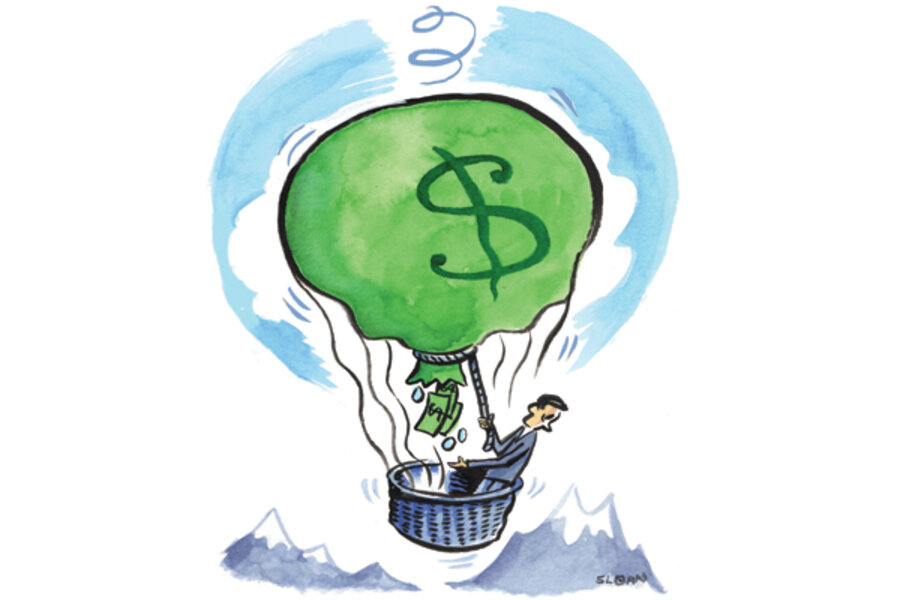More Americans tap retirement funds. Is that OK?
Loading...
| New York
Tapping a 401(k) retirement account has proved to be quite fruitful for the Davis family of Marietta, Ga. Three years ago – once she could do so without a penalty – Donna Davis started taking withdrawals from her 401(k) and rolling them into a self-directed Individual Retirement Account (IRA). With the funds, the Davises bought houses for rental income.
"We're now getting a much higher return with this money than we did when it was in the 401(k)," says her husband, Jay.
That's one of the very few times that dipping early into retirement funds might be advisable. Unfortunately, amid high unemployment and tighter restrictions on borrowing, rising numbers of pre-retirees are drawing down their retirement savings and borrowing against their future. Often, they have no choice.
People "want to find ways to meet their financial obligations now," says Stanley Molotsky, a financial planner in Collingswood, N.J., who hosts a radio call-in show on personal finance. He says he has fielded "far more calls than ever before from people asking about tapping IRAs or 401(k)s."
Consider the trends: At the end of 2010, 21 percent of people with a 401(k) that allowed loans had borrowed from it, according to the latest figures of the Employee Benefit Research Institute (EBRI) in Washington, D.C. That's up from 18 percent in 2008 and the highest percentage since 1996.
That one-fifth "is very worrisome," says Jeff Vollmer, a financial adviser at Hyde Park Wealth Management in Cincinnati. "That's a large head count of those who are degrading the long-term savings potential of a tax-deferred retirement program."
The average loan size is about 14 percent of the remaining account balance, EBRI data show.
Hardship withdrawals from 401(k)s are far less common than loans. However, 4 in 10 employees who leave their company cash out their 401(k)s rather than roll them into another retirement plan or let the funds sit until they retire, according to a 2012 Aon Hewitt study. The worst offenders? Young workers in their 20s, with just under half taking the money, despite the associated penalties.
Pre-retirement withdrawals from IRAs are also becoming more common. (Loans from IRAs are not permitted.) In tax year 2010, 8 percent of the IRA withdrawals were made by households headed by individuals younger than 59, which is up from 4 percent four years earlier, according to the Investment Company Institute in Washington, D.C.
Borrowing from a 401(k) has long-term ramifications, of course, but it also has short-term implications. Although the interest rate one pays is comparatively low, borrowers are reducing their cash flow to repay their loan – typically, it's deducted from their salary. And they are using after-tax dollars to replenish funds that had been sheltered from tax. Also, if workers leave their company, they must repay any outstanding 401(k) loans within 60 to 90 days of their last day on the job. Otherwise, they'll owe taxes on that outstanding balance. And if they're younger than 59-1/2, they'll also face a 10 percent penalty.
Nevertheless, for the cash-strapped, what other choices are there? Retirement savings could be their only way to pay for emergencies, financial advisers say. A common scenario is to borrow from a 401(k) when one wage earner in a household gets laid off, says Marcy Supovitz, head of the National Association of Plan Advisors in Arlington, Va. It's a way to tide the family over, adds Ms. Supovitz, who is also principal at a Worcester, Mass., consulting firm.
Actually, a 401(k) loan option has a distinct plus side, points out Jack VanDerhei, EBRI's research director. The fact that they can borrow from a 401(k) encourages people to join a plan in the first place.
If participants do borrow from their 401(k), they should treat loan repayments as a fixed-income holding, suggests David Wray, president of the Plan Sponsor Council of America, a Chicago-based trade association. They can then shift investments in their account to have a larger portion of the remaining balance in stocks. If stocks outperform bonds and other fixed-income assets (as they often do over the long run), then the drain on the retirement account can be minimized, he says.
All the same, the best option is not to touch retirement savings at all until retirement and, even then, strategically plan your withdrawals. "It would scare me to have to take a loan or early withdrawal from a 401(k) to pay basic bills," says Mr. Davis, whose wife redeployed her IRA assets and has now enhanced the family's financial future.







